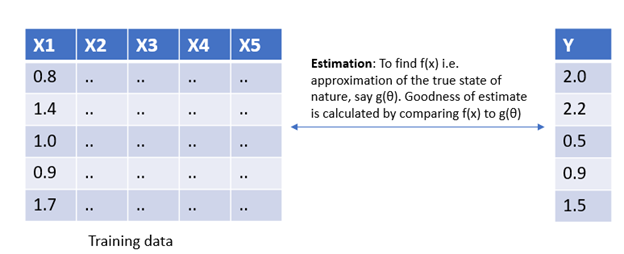置信區間估計 預測區間估計
Estimation implies finding the optimal parameter using historical data whereas prediction uses the data to compute the random value of the unseen data.
估計意味著使用歷史數據找到最佳參數,而預測則使用該數據來計算未見數據的隨機值 。
The highlighted words in the above statement need some context setting before we proceed further:
在繼續進行之前,上述語句中突出顯示的詞需要進行一些上下文設置:
We need lot of historical data to learn dependencies for machine learning and modelling. The data typically involves multiple observations, where each observation consists of multiple variables. This multivariate observation x belongs to random variable X whose distribution lies in the realm of a finite set of possible distributions called as ‘the states of nature’.
我們需要大量的歷史數據來學習機器學習和建模的依賴關系。 數據通常包含多個觀察值,其中每個觀察值都包含多個變量。 該多元觀測值x屬于隨機變量X,其分布位于稱為“自然狀態”的有限分布的可能范圍內。
Estimation is the process of optimizing the true state of nature. Loosely speaking, estimation is related to model building i.e. finding the most appropriate parameter that best describes the multivariate distribution of historical data, for e.g. if we have five independent variables, X1, X2….X5 and Y as the target variable. Then, estimation involves the process of finding f(x) which is the closest approximation of the true state of nature denoted by g(θ).
估計是優化自然真實狀態的過程 。 寬松地說,估計與模型構建有關,即找到最能描述歷史數據多元分布的最合適參數,例如,如果我們有五個獨立變量X1,X2….X5和Y作為目標變量。 然后,估計涉及尋找f(x)的過程,f(x)是由g(θ)表示的真實自然狀態的最近似值。

Whereas, prediction leverages the already built model to compute the out of sample values. It is a process of calculating the value of another random variable Z whose distribution is related to the true state of the nature (this property plays a pivotal role in any machine learning algorithm). Predictions are considered good when they agree over all the possible values of Z, on an average.
而預測則利用已經建立的模型來計算樣本外值。 這是計算另一個隨機變量Z的值的過程,該變量的分布與自然的真實狀態有關(此屬性在任何機器學習算法中都起著關鍵作用)。 平均而言,當預測與Z的所有可能值一致時,這些預測就被認為是好的。

There are multiple ways to interpret the difference between the two, let’s also explore the Bayesian intuition:
解釋兩者之間差異的方法有多種,讓我們還探討貝葉斯直覺 :
Estimation is after the occurrence of the event i.e. posterior probability. Prediction is a kind of estimation before the occurrence of the event i.e. apriori probability.
估計是在事件發生之后,即后驗概率。 預測是在事件發生之前進行的一種估計,即先驗概率。
Let’s summarize our understanding on estimation and prediction: To make predictions on unseen data, we fit a model on training dataset that learns an estimator f(x), which is used to make predictions on new data.
讓我們總結一下對估計和預測的理解:為了對看不見的數據進行預測,我們在訓練數據集上擬合了一個模型,該模型學習了估計器f(x),該函數用于對新數據進行預測。
Now, that we understand what the prediction is, let’s see how it is different from forecasting.
現在,我們了解了預測是什么,讓我們看看它與預測有何不同。
Forecasting problems are a subset of prediction problems wherein both use the historical data and talk about the future events. The only difference between forecasting and prediction is the explicit addition of temporal dimension in forecasting.
預測問題是預測問題的子集,其中既使用歷史數據,又談論未來事件。 預測與預測之間的唯一區別是在預測中顯式增加了時間維度。
Forecast is a time-based prediction i.e. it is more appropriate while dealing with time series data. Prediction, on the other hand, need not be time based only, it can be based on multiple causal factors that influence the target variable.
預測是基于時間的預測,即在處理時間序列數據時更合適。 另一方面,預測不必僅基于時間,它可以基于影響目標變量的多個因果因素。
I stumbled across a very fresh perspective of explaining the difference between the prediction and forecast using the analogy of the origin of the words themselves.
我偶然發現了一個非常新穎的觀點,即使用單詞本身的起源來解釋預測與預測之間的差異。
I will brief on this innovative illustration in this post, but you can read more about it at the original post here.
我將在這篇文章中簡要介紹這個創新的插圖,但是您可以在此處的原始文章中了解更多有關它的信息。
Forecast is more process-oriented and follows a certain methodology of doing something. In a way, it assumes that the past behavior is a good enough indicator of what is going to happen in the future.
預測更注重過程,并遵循某種方法進行工作。 在某種程度上,它假設過去的行為足以說明將來會發生什么。
Prediction considers all historical processes, influencing variables and interactions to reveal the future.
預測考慮了所有歷史過程,影響變量和相互作用以揭示未來。
In summary, all forecasts are predictions but not all predictions are forecasts.
總之,所有預測都是預測,但并非所有預測都是預測。
Hope you now have clarity on the difference between estimation and prediction. The post also highlights the distinction between prediction vs forecast.
希望您現在對估計和預測之間的區別有所了解。 該帖子還強調了預測與預測之間的區別。
Happy Reading!!!
閱讀愉快!
References: https://stats.stackexchange.com/questions/17773/what-is-the-difference-between-estimation-and-prediction/17789#17789
參考: https : //stats.stackexchange.com/questions/17773/what-is-the-difference-between-estimation-and-prediction/17789#17789
翻譯自: https://towardsdatascience.com/estimation-prediction-and-forecasting-40c56a5be0c9
置信區間估計 預測區間估計
本文來自互聯網用戶投稿,該文觀點僅代表作者本人,不代表本站立場。本站僅提供信息存儲空間服務,不擁有所有權,不承擔相關法律責任。 如若轉載,請注明出處:http://www.pswp.cn/news/392064.shtml 繁體地址,請注明出處:http://hk.pswp.cn/news/392064.shtml 英文地址,請注明出處:http://en.pswp.cn/news/392064.shtml
如若內容造成侵權/違法違規/事實不符,請聯系多彩編程網進行投訴反饋email:809451989@qq.com,一經查實,立即刪除!




)






 - JVM監控與調優【轉】)






